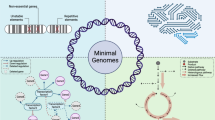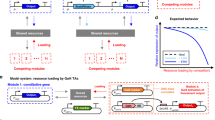Abstract
Technologies to synthesize and transplant a complete genome into a cell have opened limitless potential to redesign organisms for complex, specialized tasks. However, large-scale re-engineering of a biological circuit will require systems-level optimization that will come from a deep understanding of operational relationships among all the constituent parts of a cell. The integrated framework necessary for conducting such complex bioengineering requires the convergence of systems and synthetic biology. Here, we review the status of these rapidly developing interdisciplinary fields of biology and provide a perspective on plausible venues for their merger.
This is a preview of subscription content, access via your institution
Access options
Subscribe to this journal
Receive 12 print issues and online access
$209.00 per year
only $17.42 per issue
Buy this article
- Purchase on Springer Link
- Instant access to full article PDF
Prices may be subject to local taxes which are calculated during checkout


Similar content being viewed by others
References
Yeh, B. J. & Lim, W. A. Synthetic biology: lessons from the history of synthetic organic chemistry. Nature Chem. Biol. 3, 521–525 (2007).
Williams, D. C., Frank, R. M. V., Muth, W. L. & Burnett, J. P. Cytoplasmic inclusion bodies in Escherichia coli producing biosynthetic human insulin proteins. Science 215, 687–689 (1982).
Bonneau, R. et al. A predictive model for transcriptional control of physiology in a free living cell. Cell 131, 1354–1365 (2007).
Faith, J. J. et al. Large-scale mapping and validation of Escherichia coli transcriptional regulation from a compendium of expression profiles. PLoS Biol. 5, e8 (2007).
Sprinzak, D. & Elowitz, M. B. Reconstruction of genetic circuits. Nature 438, 443–448 (2005).
Sharma, S. S., Blattner, F. R. & Harcum, S. W. Recombinant protein production in an Escherichia coli reduced genome strain. Metab. Eng. 9, 133–141 (2007).
Grilly, C., Stricker, J., Pang, W. L., Bennett, M. R. & Hasty, J. A synthetic gene network for tuning protein degradation in Saccharomyces cerevisiae. Mol. Syst. Biol. 3, 127 (2007).
Cox, M. M. & Battista, J. R. Deinococcus radiodurans — the consummate survivor. Nature Rev. Microbiol. 3, 882–892 (2005).
Laksanalamai, P., Whitehead, T. A. & Robb, F. T. Minimal protein-folding systems in hyperthermophilic archaea. Nature Rev. Microbiol. 2, 315–324 (2004).
Shi, L., Squier, T. C., Zachara, J. M. & Fredrickson, J. K. Respiration of metal (hydr)oxides by Shewanella and Geobacter: a key role for multihaem c-type cytochromes. Mol. Microbiol. 65, 12–20 (2007).
Brenner, K., You, L. & Arnold, F. H. Engineering microbial consortia: a new frontier in synthetic biology. Trends Biotechnol. 26, 483–489 (2008).
Mukhopadhyay, A., Redding, A. M., Rutherford, B. J. & Keasling, J. D. Importance of systems biology in engineering microbes for biofuel production. Curr. Opin. Biotechnol. 19, 228–234 (2008).
de Lorenzo, V. Systems biology approaches to bioremediation. Curr. Opin. Biotechnol. 19, 579–589 (2008).
Anderson, J. C., Clarke, E. J., Arkin, A. P. & Voigt, C. A. Environmentally controlled invasion of cancer cells by engineered bacteria. J. Mol. Biol. 355, 619–627 (2006).
Boldt, J. & Muller, O. Newtons of the leaves of grass. Nature Biotechnol. 26, 387–389 (2008).
Rai, A. & Boyle, J. Synthetic biology: caught between property rights, the public domain, and the commons. PLoS Biol. 5, e58 (2007).
Dingermann, T. Recombinant therapeutic proteins: production platforms and challenges. Biotechnol. J. 3, 90–97 (2008).
Shewry, P. R., Jones, H. D. & Halford, N. G. Plant biotechnology: transgenic crops. Adv. Biochem. Eng. Biotechnol. 111, 149–186 (2008).
Wang, K., Neumann, H., Peak-Chew, S. Y. & Chin, J. W. Evolved orthogonal ribosomes enhance the efficiency of synthetic genetic code expansion. Nature Biotechnol. 25, 770–777 (2007).
Pósfai, G. et al. Emergent properties of reduced-genome Escherichia coli. Science 312, 1044–1046 (2006).
Kafri, R., Levy, M. & Pilpel, Y. The regulatory utilization of genetic redundancy through responsive backup circuits. Proc. Natl Acad. Sci. USA 103, 11653–11658 (2006).
Smith, H. O., Hutchison, C. A., Pfannkoch, C. & Venter, J. C. Generating a synthetic genome by whole genome assembly: phiX174 bacteriophage from synthetic oligonucleotides. Proc. Natl Acad. Sci. USA 100, 15440–15445 (2003).
Gibson, D. G. et al. Complete chemical synthesis, assembly, and cloning of a Mycoplasma genitalium genome. Science 319, 1215–1220 (2008).
Lartigue, C. et al. Genome transplantation in bacteria: changing one species to another. Science 317, 632–638 (2007).
Noireaux, V., Bar-Ziv, R., Godefroy, J., Salman, H. & Libchaber, A. Toward an artificial cell based on gene expression in vesicles. Phys. Biol. 2, P1–P8 (2005).
Serrano, L. Synthetic biology: promises and challenges. Mol. Syst. Biol. 3, 158 (2007).
Martin, V. J., Pitera, D. J., Withers, S. T., Newman, J. D. & Keasling, J. D. Engineering a mevalonate pathway in Escherichia coli for production of terpenoids. Nature Biotechnol. 21, 796–802 (2003).
Ro, D. K. et al. Production of the antimalarial drug precursor artemisinic acid in engineered yeast. Nature 440, 940–943 (2006).
Wei, M. Q., Mengesha, A., Good, D. & Anné, J. Bacterial targeted tumour therapy-dawn of a new era. Cancer Lett. 259, 16–27 (2008).
Atsumi, S., Hanai, T. & Liao, J. C. Non-fermentative pathways for synthesis of branched-chain higher alcohols as biofuels. Nature 451, 86–89 (2008).
Guido, N. J. et al. A bottom-up approach to gene regulation. Nature 439, 856–860 (2006).
Bennett, M. R. et al. Metabolic gene regulation in a dynamically changing environment. Nature 454, 1119–1122 (2008).
Isaacs, F. J., Hasty, J., Cantor, C. R. & Collins, J. J. Prediction and measurement of an autoregulatory genetic module. Proc. Natl Acad. Sci. USA 100, 7714–7719 (2003).
Gardner, T. S., Cantor, C. R. & Collins, J. J. Construction of a genetic toggle switch in Escherichia coli. Nature 403, 339–342 (2000).
Elowitz, M. B. & Leibler, S. A synthetic oscillatory network of transcriptional regulators. Nature 403, 335–338 (2000).
Fung, E. et al. A synthetic gene-metabolic oscillator. Nature 435, 118–122 (2005).
Maheshri, N. & O'Shea, E. K. Living with noisy genes: how cells function reliably with inherent variability in gene expression. Annu. Rev. Biophys. Biomol. Struct. 36, 413–434 (2007).
López-Maury, L., Marguerat, S. & Bähler, J. Tuning gene expression to changing environments: from rapid responses to evolutionary adaptation. Nature Rev. Genet. 9, 583–593 (2008).
Endy, D. Foundations for engineering biology. Nature 438, 449–453 (2005).
Hucka, M. et al. The systems biology markup language (SBML): a medium for representation and exchange of biochemical network models. Bioinformatics 19, 524–531 (2003).
Canton, B., Labno, A. & Endy, D. Refinement and standardization of synthetic biological parts and devices. Nature Biotechnol. 26, 787–793 (2008).
Aderem, A. Systems biology: its practice and challenges. Cell 121, 511–513 (2005).
Schmid, A. K. & Baliga, N. S. in Systems Biology Vol. 5 (eds Al-Rubeai, M. & Fussenegger, M.) 395–423 (Springer, New York, 2007).
Laub, M. T., Shapiro, L. & McAdams, H. H. Systems biology of Caulobacter. Annu. Rev. Genet. 41, 429–441 (2007).
Wang, X., Wu, M., Li, Z. & Chan, C. Short time-series microarray analysis: methods and challenges. BMC Syst. Biol. 2, 58 (2008).
Facciotti, M. T., Bonneau, R., Hood, L. & Baliga, N. S. Systems biology experimental design: considerations for building predictive gene regulatory network models for prokaryotic systems. Curr. Genomics 5, 527–544 (2004).
Reiss, D. J., Baliga, N. S. & Bonneau, R. Integrated biclustering of heterogeneous genome-wide datasets for the inference of global regulatory networks. BMC Bioinformatics 7, 280 (2006).
Baker, M. D., Wolanin, P. M. & Stock, J. B. Systems biology of bacterial chemotaxis. Curr. Opin. Microbiol. 9, 187–192 (2006).
Thanbichler, M. & Shapiro, L. Getting organized — how bacterial cells move proteins and DNA. Nature Rev. Microbiol. 6, 28–40 (2008).
Gama-Castro, S. et al. RegulonDB (version 6.0): gene regulation model of Escherichia coli K-12 beyond transcription, active (experimental) annotated promoters and textpresso navigation. Nucleic Acids Res. 36, D120–D124 (2008).
Medini, D. et al. Microbiology in the post-genomic era. Nature Rev. Microbiol. 6, 419–430 (2008).
Fredrickson, J. K. et al. Towards environmental systems biology of Shewanella. Nature Rev. Microbiol. 6, 592–603 (2008).
Young, D., Stark, J. & Kirschner, D. Systems biology of persistent infection: tuberculosis as a case study. Nature Rev. Microbiol. 6, 520–528 (2008).
Price, N. D., Reed, J. L. & Palsson, B. Ø. Genome-scale models of microbial cells: evaluating the consequences of constraints. Nature Rev. Microbiol. 2, 886–897 (2004).
Reed, J. L., Famili, I., Thiele, I. & Palsson, B. Ø. Towards multidimensional genome annotation. Nature Rev. Genet. 7, 130–141 (2006).
Feist, A. M. & Palsson, B. Ø. The growing scope of applications of genome-scale metabolic reconstructions using Escherichia coli. Nature Biotechnol. 26, 659–667 (2008).
David, H., Ozçelik, I. S., Hofmann, G. & Nielsen, J. Analysis of Aspergillus nidulans metabolism at the genome-scale. BMC Genomics 9, 163 (2008).
Lee, I. et al. A single gene network accurately predicts phenotypic effects of gene perturbation in Caenorhabditis elegans. Nature Genet. 40, 181–188 (2008).
Zak, D. E. & Aderem, A. Systems biology of innate immunity. Immunol. Rev. 227, 264–282 (2009).
Lusis, A. J., Attie, A. D. & Reue, K. Metabolic syndrome: from epidemiology to systems biology. Nature Rev. Genet. 9, 819–830 (2008).
Zahn, J. M. & Kim, S. K. Systems biology of aging in four species. Curr. Opin. Biotechnol. 18, 355–359 (2007).
Jamshidi, N. & Palsson, B. Ø. Formulating genome-scale kinetic models in the post-genome era. Mol. Syst. Biol. 4, 171 (2008).
Ishii, N. et al. Multiple high-throughput analyses monitor the response of E. coli to perturbations. Science 316, 593–597 (2007).
Barrett, C. L., Herring, C. D., Reed, J. L. & Palsson, B. Ø. The global transcriptional regulatory network for metabolism in Escherichia coli exhibits few dominant functional states. Proc. Natl Acad. Sci. USA 102, 19103–19108 (2005).
Breitling, R., Vitkup, D. & Barrett, M. P. New surveyor tools for charting microbial metabolic maps. Nature Rev. Microbiol. 6, 156–161 (2008).
Shendure, J. et al. Accurate multiplex polony sequencing of an evolved bacterial genome. Science 309, 1728–1732 (2005).
Margulies, M. et al. Genome sequencing in microfabricated high-density picolitre reactors. Nature 437, 376–380 (2005).
Reiss, D. J., Facciotti, M. T. & Baliga, N. S. Model-based deconvolution of genome-wide DNA binding. Bioinformatics 24, 396–403 (2008).
Robertson, G. et al. Genome-wide profiles of STAT1 DNA association using chromatin immunoprecipitation and massively parallel sequencing. Nature Methods 4, 651–657 (2007).
McGrath, P. T. et al. High-throughput identification of transcription start sites, conserved promoter motifs and predicted regulons. Nature Biotechnol. 25, 584–592 (2007).
Sharan, R. & Ideker, T. Modeling cellular machinery through biological network comparison. Nature Biotechnol. 24, 427–433 (2006).
Kelley, B. P. et al. Pathblast: a tool for alignment of protein interaction networks. Nucleic Acids Res. 32, W83–W88 (2004).
Baliga, N. S. Systems biology: the scale of prediction. Science 320, 1297–1298 (2008).
Tagkopoulos, I., Liu, Y. C. & Tavazoie, S. Predictive behavior within microbial genetic networks. Science 320, 1313–1317 (2008).
Isalan, M. et al. Evolvability and hierarchy in rewired bacterial gene networks. Nature 452, 840–845 (2008).
Barrett, C. L., Kim, T. Y., Kim, H. U., Palsson, B. Ø. & Lee, S. Y. Systems biology as a foundation for genome-scale synthetic biology. Curr. Opin. Biotechnol. 17, 488–492 (2006).
Fisher, J. & Henzinger, T. A. Executable cell biology. Nature Biotechnol. 25, 1239–1249 (2007).
Schlitt, T. & Brazma, A. Current approaches to gene regulatory network modelling. BMC Bioinformatics 8 (Suppl. 6), S9 (2007).
Price, N. D. & Shmulevich, I. Biochemical and statistical network models for systems biology. Curr. Opin. Biotechnol. 18, 365–370 (2007).
Stein, M., Gabdoulline, R. R. & Wade, R. C. Bridging from molecular simulation to biochemical networks. Curr. Opin. Struct. Biol. 17, 166–172 (2007).
Ayton, G. S., Noid, W. G. & Voth, G. A. Multiscale modeling of biomolecular systems: in serial and in parallel. Curr. Opin. Struct. Biol. 17, 192–198 (2007).
Whitesides, G. M. The origins and the future of microfluidics. Nature 442, 368–373 (2006).
Melin, J. & Quake, S. R. Microfluidic large-scale integration: the evolution of design rules for biological automation. Annu. Rev. Biophys. Biomol. Struct. 36, 213–231 (2007).
Kremling, A. & Saez-Rodriguez, J. Systems biology — an engineering perspective. J. Biotechnol. 129, 329–351 (2007).
Burgard, A. P., Pharkya, P. & Maranas, C. D. Optknock: a bilevel programming framework for identifying gene knockout strategies for microbial strain optimization. Biotechnol. Bioeng. 84, 647–657 (2003).
Follows, M. J., Dutkiewicz, S., Grant, S. & Chisholm, S. W. Emergent biogeography of microbial communities in a model ocean. Science 315, 1843–1846 (2007).
Meyer, A., Pellaux, R. & Panke, S. Bioengineering novel in vitro metabolic pathways using synthetic biology. Curr. Opin. Microbiol. 10, 246–253 (2007).
Doktycz, M. J. & Simpson, M. L. Nano-enabled synthetic biology. Mol. Syst. Biol. 3, 125 (2007).
Longo, D. & Hasty, J. Dynamics of single-cell gene expression. Mol. Syst. Biol. 2, 64 (2006).
Raes, J. & Bork, P. Molecular eco-systems biology: towards an understanding of community function. Nature Rev. Microbiol. 6, 693–699 (2008).
Hood, L. & Galas, D. The digital code of DNA. Nature 421, 444–448 (2003).
Bennett, S. T., Barnes, C., Cox, A., Davies, L. & Brown, C. Toward the 1,000 dollars human genome. Pharmacogenomics 6, 373–382 (2005).
Hoheisel, J. D. Microarray technology: beyond transcript profiling and genotype analysis. Nature Rev. Genet. 7, 200–210 (2006).
Gresham, D., Dunham, M. J. & Botstein, D. Comparing whole genomes using DNA microarrays. Nature Rev. Genet. 9, 291–302 (2008).
Ren, B. et al. Genome-wide location and function of DNA binding proteins. Science 290, 2306–2309 (2000).
Suzuki, M. M. & Bird, A. DNA methylation landscapes: provocative insights from epigenomics. Nature Rev. Genet. 9, 465–476 (2008).
Aebersold, R. & Mann, M. Mass spectrometry-based proteomics. Nature 422, 198–207 (2003).
Phizicky, E., Bastiaens, P. I., Zhu, H., Snyder, M. & Fields, S. Protein analysis on a proteomic scale. Nature 422, 208–215 (2003).
Sali, A., Glaeser, R., Earnest, T. & Baumeister, W. From words to literature in structural proteomics. Nature 422, 216–225 (2003).
Want, E. J., Nordstrom, A., Morita, H. & Siuzdak, G. From exogenous to endogenous: the inevitable imprint of mass spectrometry in metabolomics. J. Proteome Res. 6, 459–468 (2007).
Barabasi, A. L. & Oltvai, Z. N. Network biology: understanding the cell's functional organization. Nature Rev. Genet. 5, 101–113 (2004).
Karlebach, G. & Shamir, R. Modelling and analysis of gene regulatory networks. Nature Rev. Mol. Cell Biol. 9, 770–780 (2008).
Shannon, P. T., Reiss, D. J., Bonneau, R. & Baliga, N. S. The gaggle: an open-source software system for integrating bioinformatics software and data sources. BMC Bioinformatics 7, 176 (2006).
Acknowledgements
This work was supported by grants from the National Institutes of Health (NIH; P50GM076547 and 1R01GM077398-01A2), Department of Environment (DoE; DE-FG02-07ER64327 and DE-FG02-07ER64327), National Science Foundation (NSF; EF-0313754, EIA-0220153, MCB-0425825 and DBI-0640950) and NASA (National Aeronautics and Space Administration; NNG05GN58G) to N.S.B. The authors thank D. Reiss and A. Schmid for critical reading of the manuscript and R. Vencio for helpful discussions.
Author information
Authors and Affiliations
Corresponding author
Related links
Related links
DATABASES
Entrez Genome Project
FURTHER INFORMATION
Rights and permissions
About this article
Cite this article
Koide, T., Lee Pang, W. & Baliga, N. The role of predictive modelling in rationally re-engineering biological systems. Nat Rev Microbiol 7, 297–305 (2009). https://doi.org/10.1038/nrmicro2107
Published:
Issue Date:
DOI: https://doi.org/10.1038/nrmicro2107
This article is cited by
-
Unraveling interactions in microbial communities - from co-cultures to microbiomes
Journal of Microbiology (2015)
-
Identification of alterations in the Jacobian of biochemical reaction networks from steady state covariance data at two conditions
Journal of Mathematical Biology (2014)
-
Synthetic Biology and Synthetic Knowledge
Biological Theory (2013)
-
Recent advances in 2D and 3D in vitro systems using primary hepatocytes, alternative hepatocyte sources and non-parenchymal liver cells and their use in investigating mechanisms of hepatotoxicity, cell signaling and ADME
Archives of Toxicology (2013)
-
Programming an in vitro DNA oscillator using a molecular networking strategy
Molecular Systems Biology (2011)



